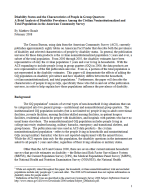Disability Status and the Characteristics of People in Group Quarters
Disability Status and the Characteristics of People in Group Quarters
Introduction
The Census Bureau, using data from the American Community Survey (ACS), currently publishes approximately eighty tables on American Fact Finder that describe both the prevalence of disability and selected characteristics of people by disability status. In general, the publication universe for these data products is the civilian noninstitutionalized population 5 years and over, a subset of the total population. From 2000 thr ough 2005, the disability estimates have been representative of only th e civilian population 5 years and over living in households. With the ACS expanding to include people living in group quarters (GQ) in 2006, the data products are now representative of the full publication universe. Even so, a por tion of the total population is not represented in the disability estimates. This paper will demonstrate the effects of adding the GQ population on disability prevalence and how disability differs between the household, civilian noninstitutionalized, and total populations. 1 Furthermore, the paper will describe the characteristics of people living in GQs, specifically those who fall in and out of the publication universe, in order to help explain how these populations influence the prevalence of disability.




